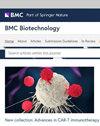人体血浆中羧甲基赖氨酸和羧乙基赖氨酸的定量分析:利用液相色谱-串联质谱法进行衰老研究的临床启示
IF 3.5
3区 生物学
Q2 BIOTECHNOLOGY & APPLIED MICROBIOLOGY
引用次数: 0
摘要
本研究的目的是利用液相色谱-串联质谱法(LC-MS/MS)建立一种测定人体血浆中羧甲基赖氨酸(CML)和羧乙基赖氨酸(CEL)浓度的方法。检测结果还可用于临床老化研究。人体血浆样本先与全氟戊酸(NFPA)水溶液混合,然后用三氯乙酸沉淀,用盐酸水解,氮气干燥,最后用全氟戊酸再溶解,然后过滤。加入肉碱-D3 作为内标。采用 Agela Venusil ASB C18 色谱柱(50 mm × 4.6 mm,5 μm),5 mmol/L NFPA 和含 0.15%甲酸的乙腈/水(60:40 (v/v))进行分离。采用多反应监测模式检测 CML、CEL 和 cotinine-D3,CML 的离子对分别为 m/z 205.2 > 84.1(定量)和 m/z 205.2 > m/z 130.0,CEL 的离子对分别为 m/z 219.1 > 84.1(定量)和 m/z 219.1 > m/z 130.1,cotinine-D3 的离子对分别为 m/z 180.1 > 80.1。在总共 6 分钟的分析时间内完成了 CML 和 CEL 的分离。CML、CEL 和可替宁-D3 的保留时间分别为 3.43 分钟、3.46 分钟和 4.50 分钟。该测定在 0.025-1.500 μmol/L 浓度范围内呈线性关系,两种化合物的定量下限均为 0.025 μmol/L。日内和日间相对标准偏差均低于 9%,相对误差均在±4%范围内。CML 的平均回收率为 94.24%,CEL 的平均回收率为 97.89%。结果表明,所开发的方法快速、灵敏度高、特异性强、重现性好,适用于临床人体血浆样本中 CML 和 CEL 的快速检测。老龄化临床研究项目的成果凸显了这两项指标对人类老龄化研究的重要指示意义。本文章由计算机程序翻译,如有差异,请以英文原文为准。
Quantifying carboxymethyl lysine and carboxyethyl lysine in human plasma: clinical insights into aging research using liquid chromatography-tandem mass spectrometry
The objective of this study was to establish a methodology for determining carboxymethyl lysine (CML) and carboxyethyl lysine (CEL) concentrations in human plasma using liquid chromatography-tandem mass spectrometry (LC-MS/MS). The test results were also used for clinical aging research. Human plasma samples were incubated with aqueous perfluorovaleric acid (NFPA), succeeded by precipitation utilizing trichloroacetic acid, hydrolysis facilitated by hydrochloric acid, nitrogen drying, and ultimate re-dissolution utilizing NFPA, followed by filtration. Cotinine-D3 was added as an internal standard. The separation was performed on an Agela Venusil ASB C18 column (50 mm × 4.6 mm, 5 μm) with a 5 mmol/L NFPA and acetonitrile/water of 60:40 (v/v) containing 0.15% formic acid. The multiple reaction monitoring mode was used for detecting CML, CEL, and cotinine-D3, with ion pairs m/z 205.2 > 84.1 (for quantitative) and m/z 205.2 > m/z 130.0 for CML, m/z 219.1 > 84.1 (for quantitative) and m/z 219.1 > m/z 130.1 for CEL, and m/z 180.1 > 80.1 for cotinine-D3, respectively. The separation of CML and CEL was accomplished within a total analysis time of 6 minutes. The retention times of CML, CEL, and cotinine-D3 were 3.43 minutes, 3.46 minutes, and 4.50 minutes, respectively. The assay exhibited linearity in the concentration range of 0.025–1.500 μmol/L, with a lower limit of quantification of 0.025 μmol/L for both compounds. The relative standard deviations of intra-day and inter-day were both below 9%, and the relative errors were both within the range of ±4%. The average recoveries were 94.24% for CML and 97.89% for CEL. The results indicate that the developed methodology is fast, highly sensitive, highly specific, reproducible, and suitable for the rapid detection of CML and CEL in clinical human plasma samples. The outcomes of the clinical research project on aging underscored the important indicative significance of these two indicators for research on human aging.
求助全文
通过发布文献求助,成功后即可免费获取论文全文。
去求助
来源期刊

BMC Biotechnology
工程技术-生物工程与应用微生物
CiteScore
6.60
自引率
0.00%
发文量
34
审稿时长
2 months
期刊介绍:
BMC Biotechnology is an open access, peer-reviewed journal that considers articles on the manipulation of biological macromolecules or organisms for use in experimental procedures, cellular and tissue engineering or in the pharmaceutical, agricultural biotechnology and allied industries.
 求助内容:
求助内容: 应助结果提醒方式:
应助结果提醒方式:


